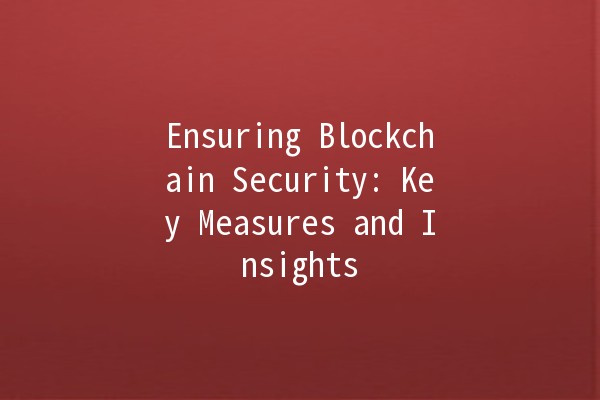
Blockchain technology has emerged as a transformative force across various sectors, promising enhanced security, transparency, and efficiency. However, as with any technological advancement, it comes with its own set of challenges, particularly concerning security. In this article, we will explore the key measures that can be employed to safeguard blockchain networks. We aim to provide actionable insights that can benefit both developers and users navigating this complex landscape.
Understanding Blockchain Security
Before diving into specific security measures, it's essential to grasp the fundamental aspects of blockchain technology. At its core, a blockchain is a decentralized ledger that records transactions across multiple computers. This decentralization enhances security by reducing the chances of a single point of failure. However, this does not render it immune to threats. Cybersecurity incidents involving blockchain can lead to data breaches, loss of financial assets, and compromised integrity.
Common Vulnerabilities in Blockchain

Recognizing these vulnerabilities helps in mitigating risks and enhancing the overall security of blockchain systems.
Key Measures for Enhancing Blockchain Security
Consensus mechanisms are fundamental to maintaining the integrity of a blockchain. Common types include Proof of Work (PoW), Proof of Stake (PoS), and Delegated Proof of Stake (DPoS).
Actionable : For developers, implementing a hybrid consensus model can be an effective way to bolster security. For instance, combining PoW and PoS allows for a balance between decentralization and energy efficiency, while also reducing the likelihood of a 51% attack.
Example: Ethereum's transition from PoW to PoS aims to enhance security and scalability, allowing validators to secure the network while being economically incentivized.
Multisignature wallets require multiple private keys to authorize a transaction. This adds an additional layer of security as it prevents a single compromised key from leading to fund theft.
Actionable : Businesses should consider using multisignature wallets for their treasury management. This ensures that multiple stakeholders must agree on transactions, reducing the risk of unauthorized access.
Example: BitGo operates a multisig wallet that allows users to establish customized rules regarding transaction approvals and fund management.
Regular security audits are critical for identifying and addressing vulnerabilities within blockchain systems, including smart contracts and application architectures.
Actionable : Organizations should establish a routine for conducting audits, perhaps quarterly or biannually, utilizing thirdparty security firms to gain an unbiased assessment.
Example: The DAO hack in 2016 demonstrated the necessity for robust audits, highlighting how overlooked vulnerabilities can be exploited, resulting in substantial financial losses. Following that incident, projects like OpenZeppelin emerged, providing comprehensive auditing services specifically for smart contracts.
Encryption plays a vital role in securing data stored on the blockchain. Utilizing strong cryptographic algorithms helps protect sensitive information from unauthorized access.
Actionable : Developers should adopt established encryption standards such as AES (Advanced Encryption Standard) to encrypt data before it is written to the blockchain. This ensures that only authorized parties have access to sensitive information.
Example: Projects like Zcash utilize advanced cryptographic techniques such as zkSNARKs to allow private transactions while maintaining the integrity of the blockchain.
User awareness is crucial in blockchain security. Educating users on recognizing phishing attempts, the importance of strong passwords, and safeguarding private keys can significantly reduce risks.
Actionable : Establish ongoing security training and awareness campaigns for users interacting with blockchain applications. Consider creating easily digestible content, such as infographics and video tutorials, to reach a broader audience.
Example: Cryptocurrency exchanges often run educational webinars and create resource centers that guide users on safely managing their assets and recognizing potential threats.
Frequently Asked Questions
What is a 51% attack, and how can it be prevented?
A 51% attack occurs when a single miner or group controls over half of the network’s mining power, enabling them to manipulate transactions or doublespend coins. To prevent this, adopting a robust consensus mechanism, like a hybrid of PoW and PoS, can help ensure decentralization remains upheld.
How do smart contracts become vulnerable?
Smart contracts can have flaws in their code that malicious actors can exploit, leading to fund misappropriation or contracts behaving unexpectedly. Regular audits and utilizing established security frameworks during coding can mitigate such risks.
What steps should I take if I suspect my wallet has been compromised?
If you suspect your wallet has been compromised, immediately transfer your funds to a new wallet with a new private key, enhanced security features (like multisig), and review your security practices to secure your accounts.
Can blockchain be completely secure?
While blockchain technology significantly enhances security through decentralization and encryption, it is not entirely impervious to threats. Continuous vigilance, regular audits, and user education are pivotal in managing and mitigating risks.
How can businesses ensure compliance while maintaining security?
Businesses can achieve this by integrating compliance frameworks into their blockchain strategies during the early development stages. Collaborating with legal experts and undergoing regular compliance audits can also help balance security and regulatory requirements.
Are there any tools available for smart contract testing?
Yes, there are numerous tools available for smart contract testing, such as Truffle, Mythril, and Slither. These tools help identify vulnerabilities during the development phase, thereby enhancing security before deployment.
With the growing reliance on blockchain technology, ensuring its security is paramount. By implementing robust measures such as diligent audits, user education, and sophisticated encryption techniques, organizations can effectively protect their systems and user data.
As blockchain continues to evolve, staying informed about potential vulnerabilities and leveraging advanced security practices will be essential for fostering trust and driving widespread adoption of this revolutionary technology.

